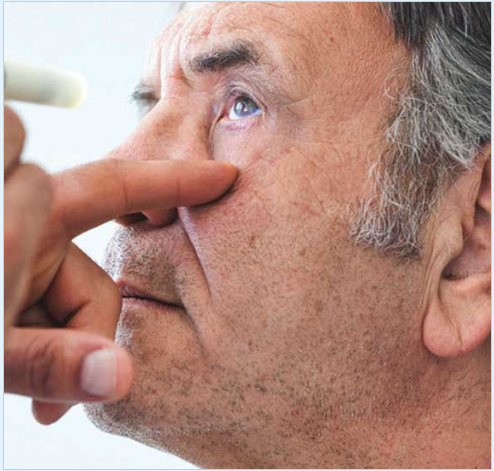Evaporative Dry Eye
Evaporative Dry Eye

What Is Evaporative Dry Eye?
 WHAT ARE THE SYMPTOMS OF EDE ?
WHAT ARE THE SYMPTOMS OF EDE ?
 grittiness, as though there’s sand in your eyes
grittiness, as though there’s sand in your eyes  stinging sensation
stinging sensation  inability to tolerate wearing contact lenses
inability to tolerate wearing contact lenses  sensitivity to light
sensitivity to light  eye fatigue, especially after working on your computer or reading
eye fatigue, especially after working on your computer or reading Your eyes may also have increased redness or your eyelids may appear swollen.
 WHAT CAUSES EDE ?
WHAT CAUSES EDE ?

Other possible factors that disrupt the meibomian glands are :

Skin Conditions, Such As Rosacea Or Scalp

Medications,Like Antihistamines, Antidepressants

Some Diseases, Like Diabetes, Thyroid Condition
Allergies That Affect Your Eyes

Vitamin A Deficiency
Wearing Contact Lenses For Long Time

Eye Injury

Eye Surgery

Some Toxins
If EDE is treated early on, the meibomian gland blockages can be reversed. In some cases, the EDE discomfort can be chronic, requiring ongoing treatment of symptoms.
 HOW IS EDE DIAGNOSED ?
HOW IS EDE DIAGNOSED ?

 How is EDE treated ?
How is EDE treated ? Treatment will depend on the severity of your symptoms and whether there’s an underlying systemic cause that needs to be treated. For instance, if a medication is contributing to your dry eye, the doctor may suggest an alternative medication. If Sjogren’s syndrome is suspected, the doctor may refer you to a specialist for treatment.
Your doctor may also suggest simple changes, such as using a humidifier to keep more moisture in the air or, if you wear contact lenses, trying a different cleaning system for your lenses.
For moderate blockage to your meibomian glands, the doctor may suggest applying warm compresses to your eyelids twice a day for four minutes each time. They may also recommend an over-the-counter lid scrub. You may have to experiment with different lid scrubs to find one that works well for you. Baby shampoo may be effective, instead of a more expensive scrub.
Your doctor may also advise eye drops or artificial tears to make your eyes more comfortable. There are many types of drops, tears, gels, and ointments, and you may need to experiment to find what works best for you.
If the blockage to your meibomian glands is more severe, other treatments are available :
- The LipiFlow thermal pulsation system, used in the doctor’s office, may help unblock the meibomian glands. The device gives your lower eyelid a gentle pulsating message for 12 minutes.
- Blinking training and exercises can help improve your meibomian gland functioning.
- Intense pulsed light therapy along with eye massage may provide some symptom relief.
- You could also take prescription medications, such as topical azithromycin, a liposomal spray, oral tetracycline, doxycycline (Monodox, Vibramycin, Adoxa, Mondoxyne NL, Morgidox, NutriDox, Ocudox), or anti-inflammatory drugs.
 What complications might occur ?
What complications might occur ? If your EDE is left untreated, the pain and discomfort may make it difficult for you to read, drive, or carry out daily activities. It can also result in serious complications. It may increase your risk of eye infections, including blinding infections, because your tears are not adequate to protect the surface of your eyes. Your eyes may become inflamed, or you may have a greater risk of scratching your cornea or damaging your eyesight.
 What’s the outlook for EDE ?
What’s the outlook for EDE ? EDE symptoms can be successfully treated in most cases. In mild cases, the problem may clear up after initial treatment. If an underlying condition like Sjogren’s syndrome is causing the problem, that condition should be treated to try and keep the eye symptoms under control. Sometimes symptoms may become chronic, and you may have to use artificial tears, eye scrubs, and medication to keep your eyes comfortable.
Ongoing research into EDE, and dry eye in general, is likely to come up with new ways to treat symptoms and prevent the meibomian glands from being blocked.
 What can you do to prevent EDE ?
What can you do to prevent EDE ?  Keep up a daily routine of warm eye compresses and lid scrubs even after your symptoms have resolved.
Keep up a daily routine of warm eye compresses and lid scrubs even after your symptoms have resolved. Blink regularly to keep your eyes lubricated.
Blink regularly to keep your eyes lubricated. Avoid smoking and being around people who smoke.
Avoid smoking and being around people who smoke. Drink plenty of water to keep hydrated.
Drink plenty of water to keep hydrated. Wear sunglasses when you’re outside to protect your eyes from sun and wind. The wraparound kind provide maximum protection.
Wear sunglasses when you’re outside to protect your eyes from sun and wind. The wraparound kind provide maximum protection.